Navegando abordo de la PO Durango por el mar de Cortes.
Estás usando un navegador obsoleto. No se pueden mostrar estos u otros sitios web correctamente.
Se debe actualizar o usar un navegador alternativo.
Se debe actualizar o usar un navegador alternativo.
Noticias de la Armada de México
- Tema iniciado IA-37P
- Fecha de inicio
PO Independencia, helicóptero Phanter, Black hawk, interceptora Polaris.
La Autoridad Marítima Nacional la ejercerá la Semar a la que se le transfiere la Capitanía de Puertos.
En un paso lógico para controlar las aduanas la SEMAR se encargará de detener el contrabando que ingresa al país a través de los puertos.
https://www.elsoldetampico.com.mx/n...ias-de-puertos-a-cargo-de-la-armada-de-mexico
http://www.radioformula.com.mx/notas.asp?Idn=648596&idFC=2016
En un paso lógico para controlar las aduanas la SEMAR se encargará de detener el contrabando que ingresa al país a través de los puertos.
https://www.elsoldetampico.com.mx/n...ias-de-puertos-a-cargo-de-la-armada-de-mexico
http://www.radioformula.com.mx/notas.asp?Idn=648596&idFC=2016
México, el socio de mayor calidad que tenemos: Marina de EU
México es el aliado estratégico y el socio de mayor calidad con el que Estados Unidos cuenta en el mundo, afirmó el secretario de Marina estadunidense, Raymond Mabus, durante una visita oficial para reunirse con su contraparte Vidal Soberón, de quien recibió la Condecoración al Mérito Especial.

Raymond Mabus:
“No tenemos ningún socio de mayor calidad, no tenemos ningún amigo mejor, no tenemos ningún aliado que sea mejor, ni nada igual que el pueblo mexicano y la Armada de México”.
“Ya sea en el entrenamiento que hacemos juntos, en los intercambios en los que participamos, en operaciones mayores como la de la Cuenca del Pacífico o en más cercanas a la costa como el Panamax, siempre trabajamos y operamos juntos, somos totalmente socios”.
“Ha sido un privilegio y un placer trabajar con ustedes para fortalecer la amistad que tenemos, es importante para nuestros dos países y es importante para el mundo, para que esta amistad siempre se mantenga así de fuerte”.
http://sipse.com/mexico/mexico-socio-mayor-calidad-tenemos-marina-eu-234975.html
http://www.milenio.com/policia/EU-a...ario_de_marina-raymond_edwin_0_866913602.html
México es el aliado estratégico y el socio de mayor calidad con el que Estados Unidos cuenta en el mundo, afirmó el secretario de Marina estadunidense, Raymond Mabus, durante una visita oficial para reunirse con su contraparte Vidal Soberón, de quien recibió la Condecoración al Mérito Especial.

Raymond Mabus:
“No tenemos ningún socio de mayor calidad, no tenemos ningún amigo mejor, no tenemos ningún aliado que sea mejor, ni nada igual que el pueblo mexicano y la Armada de México”.
“Ya sea en el entrenamiento que hacemos juntos, en los intercambios en los que participamos, en operaciones mayores como la de la Cuenca del Pacífico o en más cercanas a la costa como el Panamax, siempre trabajamos y operamos juntos, somos totalmente socios”.
“Ha sido un privilegio y un placer trabajar con ustedes para fortalecer la amistad que tenemos, es importante para nuestros dos países y es importante para el mundo, para que esta amistad siempre se mantenga así de fuerte”.
http://sipse.com/mexico/mexico-socio-mayor-calidad-tenemos-marina-eu-234975.html
http://www.milenio.com/policia/EU-a...ario_de_marina-raymond_edwin_0_866913602.html
Vehículo 4x4 blindado ligero de exploración de fabricación estadounidense Mack Defense, Sherpa Scout de la Armada de México.
Adquiridos en 2016, ignoramos aún la cantidad de ellos. Esta unidad se ve artillada con una ametralladora pesada Browning M2 de calibre .50.
El Sherpa pertenece a una familia de vehículos tácticos del orden de las 8 a las 11 toneladas de peso, que se pueden blindar para transportar personal de infantería, realizar misiones de reconocimiento, patrullaje, evacuación médica, puesto de mando, entre otros, el cual cuenta con capacidades para desplazarse fuera de los caminos y cruzar cuerpos de agua de hasta 1.5 metros de profundidad. Además es aerotransportable.
Emplea un motor a diésel Renault MD5 de cuatro cilindros con 265 hp y transmisión automática. Puede transportar hasta seis personas. Cuenta con una cabina blindada con cuatro puertas. Tiene un parachoques frontal y cabrestante, y en la parte posterior una caja también blindada para transportar más personal o carga. En la parte superior tiene una escotilla para el tirador y una torreta blindada. Sus neumáticos pueden rodar sin aire en caso de un impacto balístico.

Adquiridos en 2016, ignoramos aún la cantidad de ellos. Esta unidad se ve artillada con una ametralladora pesada Browning M2 de calibre .50.
El Sherpa pertenece a una familia de vehículos tácticos del orden de las 8 a las 11 toneladas de peso, que se pueden blindar para transportar personal de infantería, realizar misiones de reconocimiento, patrullaje, evacuación médica, puesto de mando, entre otros, el cual cuenta con capacidades para desplazarse fuera de los caminos y cruzar cuerpos de agua de hasta 1.5 metros de profundidad. Además es aerotransportable.
Emplea un motor a diésel Renault MD5 de cuatro cilindros con 265 hp y transmisión automática. Puede transportar hasta seis personas. Cuenta con una cabina blindada con cuatro puertas. Tiene un parachoques frontal y cabrestante, y en la parte posterior una caja también blindada para transportar más personal o carga. En la parte superior tiene una escotilla para el tirador y una torreta blindada. Sus neumáticos pueden rodar sin aire en caso de un impacto balístico.

Derruido
Colaborador
Que feo diseño, parece que agarraron unas cuantas chapas soldaron y cerraron los espacios abiertos de otro diseñod de buque.OPV Clase Durango

Besos
Que feo diseño, parece que agarraron unas cuantas chapas soldaron y cerraron los espacios abiertos de otro diseñod de buque.
Besos
Acá se puede ver mejor.
No son espacios abiertos soldados.


De igual forma es una clase anterior de OPV construida en México.
El Actual diseño sobre el que se construyen OPV es la Clase Oaxaca.

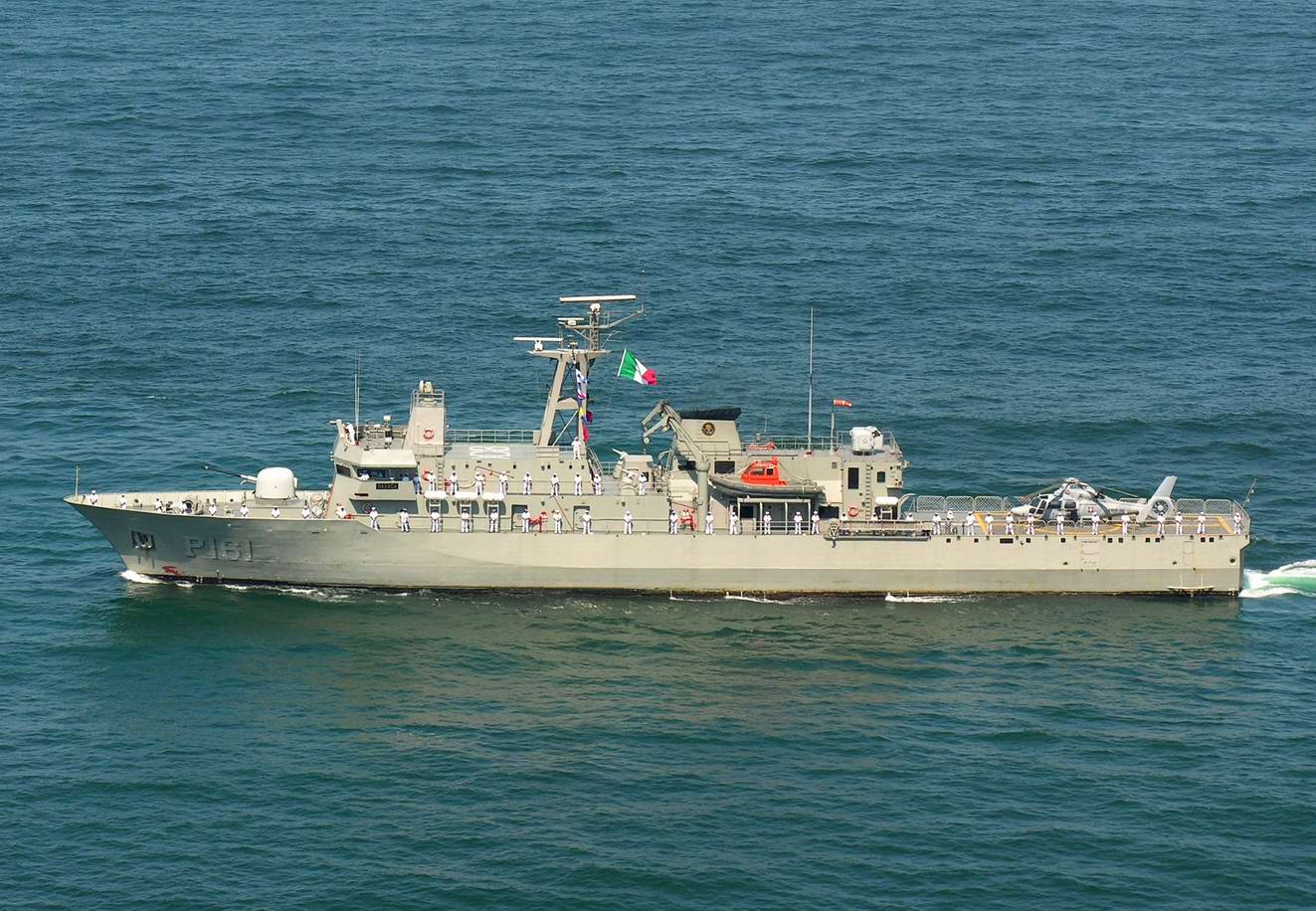
De hecho no les caerían mal un par para su PNA!
Derruido
Colaborador
Es que es un diseño forzado, ese cerramiento. No se lo vé como algo natural del diseño y mostrandome los buques me dá la razón.Acá se puede ver mejor.
No son espacios abiertos soldados.


De igual forma es una clase anterior de OPV construida en México.
El Actual diseño sobre el que se construyen OPV es la Clase Oaxaca.


De hecho no les caerían mal un par para su PNA!
Besos
Feliz Navidad a todos los hermanos de Latinoamérica, un abrazo desde México!




Última edición:
Last of the Gearings
July 4, 2015 jwh19754 Comments
The Gearing class was the US Navy’s final destroyer design of WWII. Without question, it was the best and most sophisticated destroyer class of WWII. Many naval historians consider it the best destroyer design ever. These ships served long after WWII in the US Navy, then were transferred around the world, serving many navies on four continents. The Mexican navy received two of these ships. One, ARM Netzahualcoyotl, ended up being the last Gearing on active duty in the world.
USS Steinaker (DD-863) was launched on 13 February 1945 at Bethlehem Steel’s Staten Island, NY shipyard. The ship commissioned on 26 May 1945.
 (USS Steinaker (DD-863) during WWII, in the original Gearing configuration.)
(USS Steinaker (DD-863) during WWII, in the original Gearing configuration.)
USS Steinaker saw no actual combat during WWII, as the ship had been attached to the US Navy’s 6th Fleet in the Atlantic and Mediterranean after Germany had already surrendered.
In 1964, USS Steinaker, like many other Gearings, underwent a FRAM conversion. The Hedgehog ASW mortars and “B” twin 5″ gun turret were removed, making way for two sets of triple ASW torpedo tubes. The amidships ship-to-ship torpedoes were replaced by a RUR-5 Asroc anti-submarine missile launcher. All of the WWII-era light (40mm, 20mm, .50cal) guns were removed, as were the depth charge racks. A helipad and small hangar for the QH-50 DASH drone helicopter was added. Infrared-retarding caps were added to the stacks. The radios, radars, and sonars were completely overhauled, and some structural changes were done.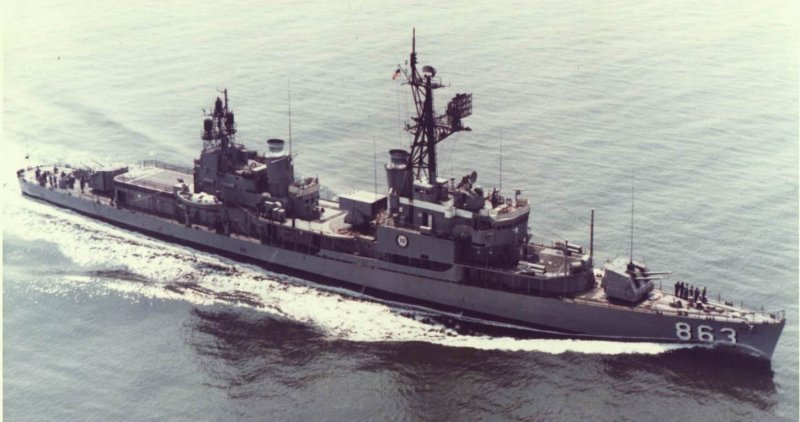
(USS Steinaker after the FRAM conversion, with the “B” turret replaced by two triple ASW tubes. The three black antennas atop the new DASH hangar are the AN/WLR-1 electronic warfare system. The “chokers” on the WWII-era stacks were meant to reduce the heat signature vs modern infrared sensors. The QH-50 DASH heli-drone was largely unsuccessful and later abandoned.)
In 1968, the modernized USS Steinaker made a combat tour off Vietnam, bombarding ashore targets with her 5″ guns. On 1 July 1973, USS Steinaker was decommissioned and transferred to the Atlantic Fleet’s 10th Destroyer Squadron naval reserve proficiency program. As such, the ship had no permanent crew and was moored pierside at Baltimore, MD; so that US Naval Reservists from Maryland and Virginia could fulfill their “….one weekend a month” obligation. This continued until 1981, when the old destroyer was judged insufficient.
Transfer to Mexico
On 24 February 1982, the US Congress agreed to the sale of the ex-USS Steinaker to Mexico. The Mexicans renamed the ship ARM Netzahuacoyotl, initially with the pennant number E-04. The destroyer was sold along with USS Steinaker‘s sister ship, the ex-USS Vogelsang (DD-852), which became ARM Quetzacoatl. The terms of the sale were fairly generous; the Mexicans did not pay much more than their scrap metal value. Basically for the USA, it was a way to clear out some reserve anchorages without the hassle of bidding a scrap job. For Mexico, it was a prime opportunity to add two open-ocean combatants to their navy, whatever their age.
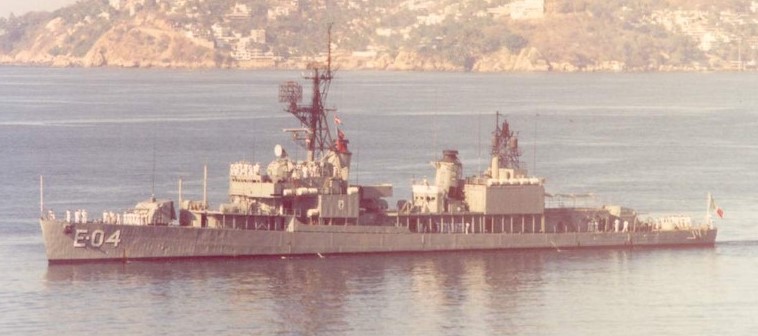
(ARM Netzahuacoyotl departs for a patrol in the Pacific Ocean in 1991. The pennant number is still E-04. The Mexican navy had a spree of ship renamings and renumberings in the 1990s and E-04 later changed to E-11 and then again to D-102.)
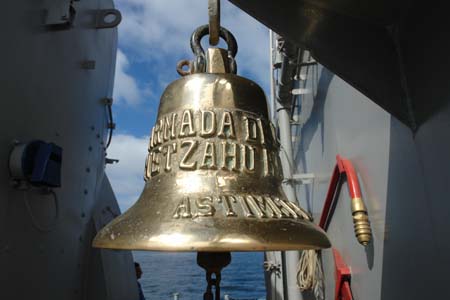
(ARM Netzahuacoyotl’s bell, which was forged in Mexico after the transfer. Since the Revolutionary War, US Navy sailors have held a superstitious respect for ship’s bells and American bells are usually removed before ex-US Navy warships are sold abroad. US Navy veterans of a certain age might recognize the red object on the bulkhead, it is an old fog applicator extension for firefighting.)
Initially no modifications were done to the ship. For Mexico, their prime assets were their range, seaworthiness in bad weather, long-range air search radars, and anti-submarine weapons.
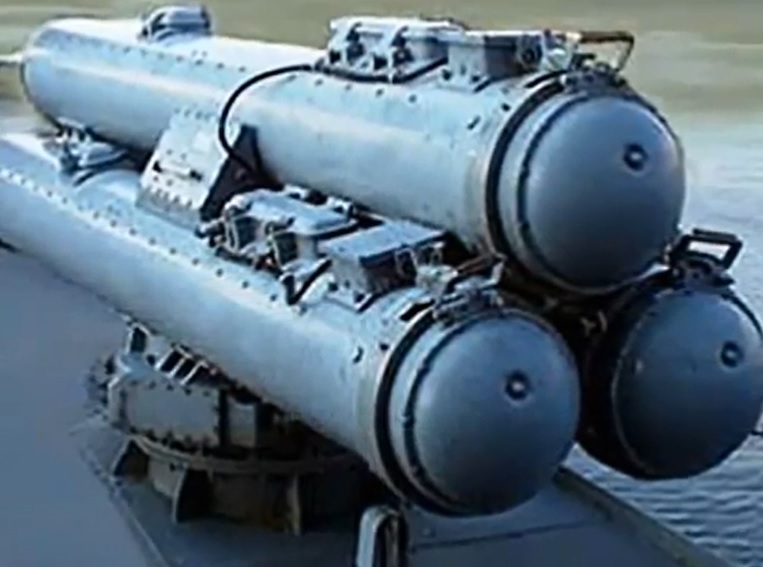
(One of ARM Netzahuacoyotl’s two Mk32 Mod7 324mm torpedo tube banks. These fired the Mk46 acoustic-homing ASW torpedo with a range of about 5 miles.)
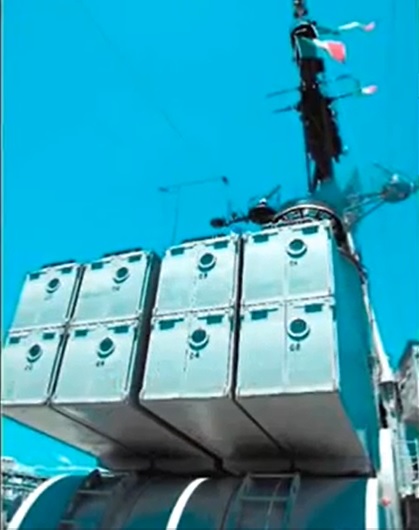
(ARM Netzahuacoyotl’s Mk112 launcher, which American sailors called “the pepperbox”, with the Mexican flag above. This launcher, installed in the 1960s to replace the WWII-era anti-ship torpedoes, fired RUR-5 Asroc ASW missiles out to 12NM range. Asroc missiles carried a homing torpedo and dropped it into the sea directly over the target submarine’s position. Normally, a submarine can detect a regular incoming torpedo and take evasive maneuvers. With Asroc, there was only a few seconds between the torpedo splashdown and it’s impact. Mexico also used the RUR-5 on it’s more modern Bronstein and Knox class warships, so ARM Netzahuacoyotl was a good training asset.)
The hangar built during the FRAM upgrade was sized for the long-forgotten little DASH heli-drone and was too cramped for a regular 1980s-era helicopter. None the less, the flight deck was still usable and the Mexican navy sometimes used ARM Netzahuacoyotl as a landing spot.
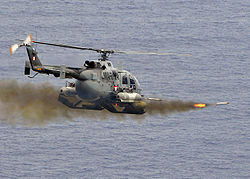
(A German-made Bo-105 helicopter of the Mexican navy firing a rocket.)
The two remaining Mk38 twin 5″ gun turrets were kept in immaculate condition by the Mexicans. They did not regard them as museum pieces and maintained excellent gunnery standards with these WWII weapons into the 21st century.
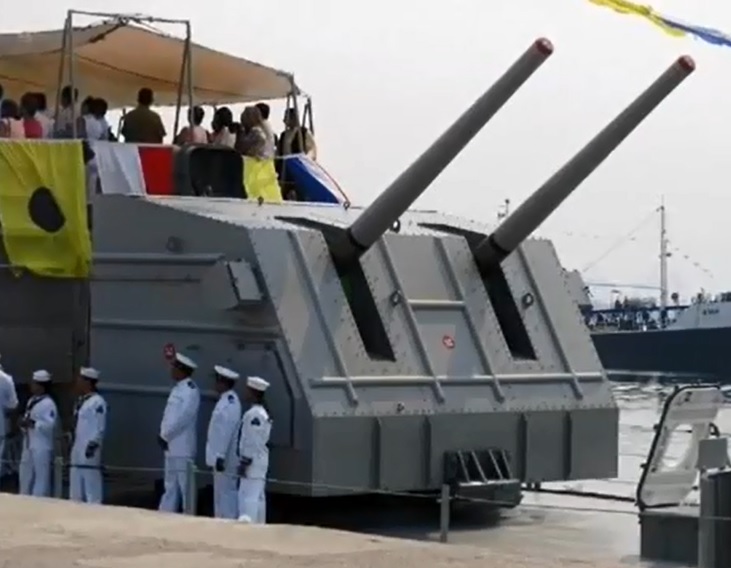 (The WWII-veteran aft Mk38 twin 5″ gun aboard ARM Netzahuacoyotl during a friendship visit to the USA in the 2000s.)
(The WWII-veteran aft Mk38 twin 5″ gun aboard ARM Netzahuacoyotl during a friendship visit to the USA in the 2000s.)
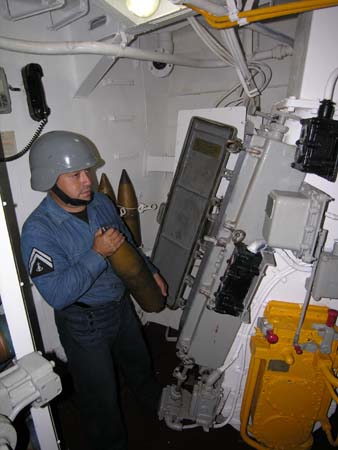
(A Mexican sailor, with modern kevlar PASGT helmet, loads a 5″ shell into the magazine shuttle for transport up into the WWII turret.)
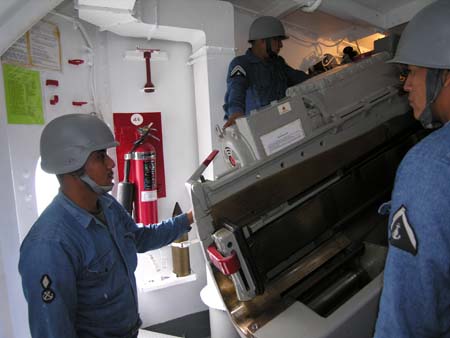
(The inside of one of ARM Netzahuacoyotl’s twin 5″ turrets during the 2000s. This shows the hand-loaded breech mechanism of the WWII-era 5″ guns. The helmets are a mix of modern kevlar PASGT and old WWII-era M1 steel pots. Considering age, the gun and the turret’s interior are in pristine condition. The Mexican navy has high shipboard standards.)
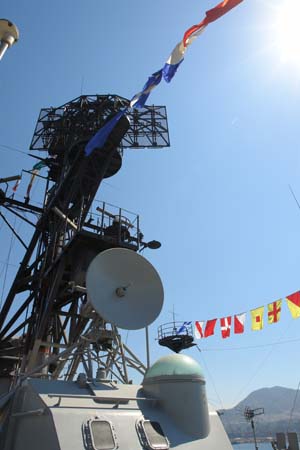
(Aboard ARM Netzahuacoyotl during the 2000s. The structure, with controlman’s bubble, in the foreground is a Mk37 director which dates back to WWII. Atop it is a Mk22 gunnery radar. This system controlled the gunfire of the 5″ weapons. On the mast can be seen the two modern AN/SPS-59 navigation radars which were added by Mexico after the transfer, and the large AN/SPS-29 air search radar which was installed during the FRAM upgrade.)
Mexican operations
Initially, the role of ARM Netzahuacoyotl was supposed to be peacetime training and wartime ASW patrols in the Pacific Ocean. The ship’s age and limited abilities were not really important, as the Mexican navy is in a unique strategic position: sandwiched between an infinitely stronger superpower navy north of the Rio Grande; and much weaker and smaller third-world navies south of the Yucatan.
As it turned out, the USA’s war on drugs, which intensified during the 1980s, ended up being the ship’s main duty. Normally, ARM Netzahuacoyotl patrolled a sea zone of the Pacific just south of the Baja peninsula northwards up to the sea border of the USA. This area was rife with trawlers, yachts, and small boats smuggling drugs from South America towards California.
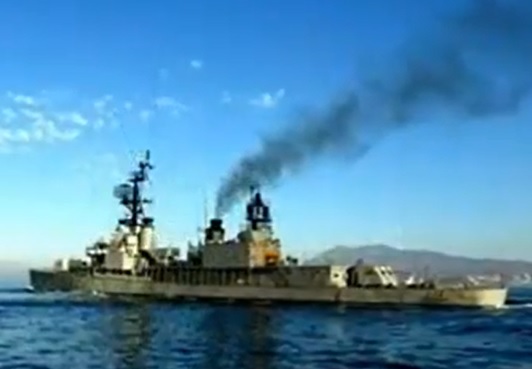
(ARM Netzahuacoyotl departing port for a “narcopatrol” in the Pacific Ocean.)
For these anti-drug missions, ARM Netzahuacoyotl‘s main assets were the ship’s wide operating radius and the air search radar. The 1960s-vintage AN/SPS-29 was obsolete in a military context by the 1990s, but, it could still detect a DC-3-sized smuggling plane at high altitude out beyond 100NM, and even small Cessnas at wavetop height out to about 38NM.
Since ARM Netzahuacoyotl‘s radios were all American, they were compatible with those of the US Coast Guard. Any suspected smuggler which ARM Netzahuacoyotl could not chase down, was vectored via radio to the DEA or US Coast Guard. The helipad allowed search helicopters a safe place to land at sea if needed. Unlike the Mexican navy’s small fiberglass anti-drug boats, the sturdy WWII-built ARM Netzahuacoyotl was not deterred by severe weather.
For the crew, a highlight of serving aboard ARM Netzahuacoyotl was a yearly visit to San Diego, CA. The Mexican navy often offered the American public tours of the old warship. If visitors were WWII-era US Navy veterans, especially old destroyermen, the crew of ARM Netzahuacoyotl went out of their way to welcome them, often showing the old-timers normally restricted areas such as the weapons magazines and radar room.
The SAK Mk.2 gun trials
In 1993, ARM Netzahuacoyotl was selected as the trials ship for the modern SAK Mk.2 gun. Manufactured by Bofors in Sweden, this 57mm autocannon is unmanned and housed in a plastic-composite structure designed for low observability by radar. It fires at 220rpm and is radar-controlled. For the trials, the two torpedo tube banks were removed and the SAK Mk.2 was installed on a temporary platform where the “B” Mk38 turret had once been, long ago in WWII.
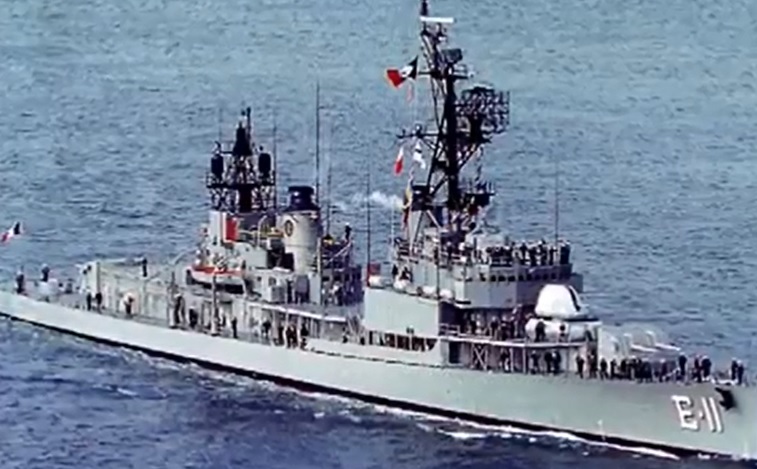 (The white Bofors 57mm autocannon installed aboard ARM Netzahuacoyotl in the mid-1990s. This photo also shows the final radar fit, with the black AN/SPS-29 and smaller AN/SPS-10 sets from the FRAM upgrade, along with the white, bar-shaped Kelvin Hughes 17/9 modern system installed by the Mexicans at the end of the 1980s atop the mast. The two AN/SPS-59 sets on the yardarms are hard to make out but there. The old AN/WLR-1 electronic warfare radomes remain aft.)
(The white Bofors 57mm autocannon installed aboard ARM Netzahuacoyotl in the mid-1990s. This photo also shows the final radar fit, with the black AN/SPS-29 and smaller AN/SPS-10 sets from the FRAM upgrade, along with the white, bar-shaped Kelvin Hughes 17/9 modern system installed by the Mexicans at the end of the 1980s atop the mast. The two AN/SPS-59 sets on the yardarms are hard to make out but there. The old AN/WLR-1 electronic warfare radomes remain aft.)
The Bofors autocannon was generations ahead of the old WWII guns and made an interesting contrast being carried on the same ship as them. Tests were successful, and the Mexican navy purchased this gun system for other new-build warships. During the tests, the Asroc launcher was also taken ashore for cleaning and repairs.
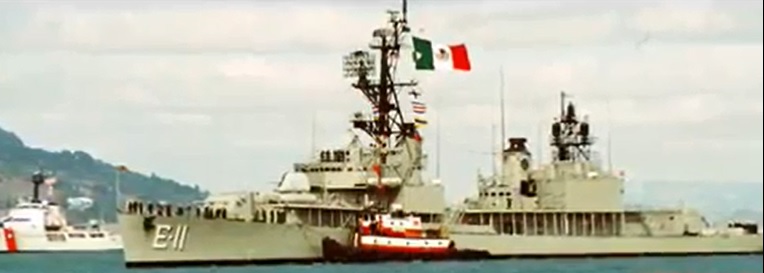 (ARM Netzahuacoyotl in the 1990s, with the Bofors 57mm mount aboard and torpedoes and Asroc temporarily taken off. A Reliance class cutter of the US Coast Guard is in the background.)
(ARM Netzahuacoyotl in the 1990s, with the Bofors 57mm mount aboard and torpedoes and Asroc temporarily taken off. A Reliance class cutter of the US Coast Guard is in the background.)
After the conclusion of the tests, there was some thought given to leaving the SAK Mk.2 aboard as it was quite popular with the destroyer’s crew. However (at that time) it was thought that ARM Netzahuacoyotl would decommission soon, so it was moved to new warship under construction. The torpedo tubes and missile launcher were reinstalled.
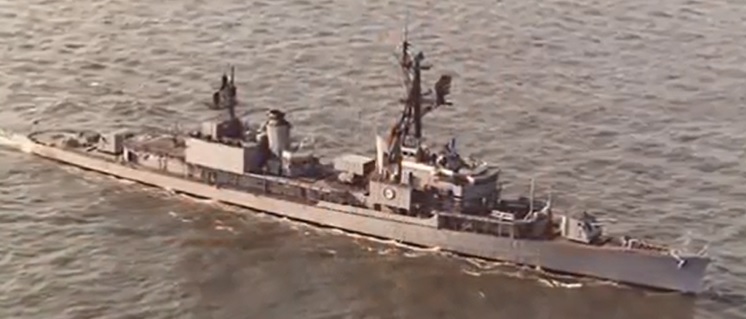 (The two triple torpedo tubes and amidships Asroc launcher back aboard after the gun tests. This was originally a Mexican navy press photo and the pennant number was airbrushed out for security.)
(The two triple torpedo tubes and amidships Asroc launcher back aboard after the gun tests. This was originally a Mexican navy press photo and the pennant number was airbrushed out for security.)
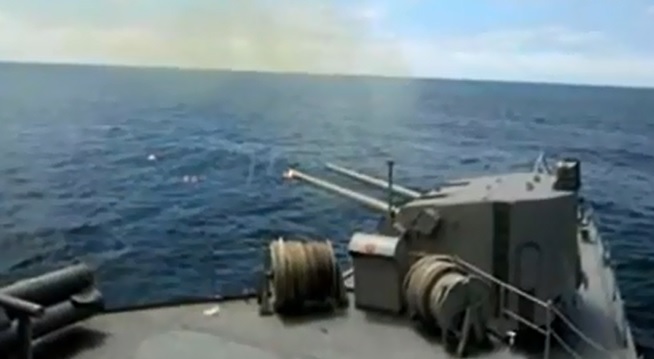 (The WWII-era forward 5″ guns of ARM Netzahuacoyotl in action in the early 2000s. These long-obsolete guns were battle ready right up until the end. To the right of the port side torpedo tubes, is a discolored area of deck where the 57mm gun mounting had been.)
(The WWII-era forward 5″ guns of ARM Netzahuacoyotl in action in the early 2000s. These long-obsolete guns were battle ready right up until the end. To the right of the port side torpedo tubes, is a discolored area of deck where the 57mm gun mounting had been.)
Final years
In 2002, Mexico’s other WWII-era Gearing class destroyer, ARM Ilhuicamina (formerly ARM Quetzalcoatl, before that USS Vogelsang) was decommissioned and it was expected that ARM Netzahuacoyotl would shortly follow. However because of the drug war, it remained in service. It was also used as a training ship for midshipmen of the Mexican naval academy.
After the turn of the millennium, the biggest handicap was the 1940s steam plant. As steam propulsion operates under high pressure and high moisture, the metal ages and there is little that can be done to reverse it after so many decades of use. ARM Netzahuacoyotl typically did not exceed 17kts after the year 2000 unless absolutely necessary.
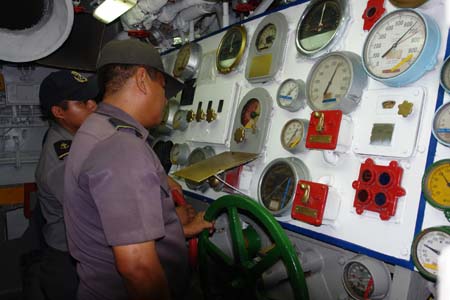
(ARM Netzahuacoyotl’s engineering officer of the watch monitors the WWII-era steam board in the late 2000s. The handwheel controls the amount of steam sent from the boilers to the geared turbines which turned the propeller shafts.)
In 2010, it was announced that the ARM Netzahuacoyotl would shortly decommission however this was again extended. A new issue at that time was ordnance. By then, the 5″ ammunition had gone out of production worldwide and Mexico’s remaining stockpile was beginning to be depleted. The RUR-5 missile had just been phased out by the US Navy, so Mexico’s remaining inventory of that missile (which cost about $375,000 each) had to be shared with more modern frigates and ARM Netzahuacoyotl obviously had last priority.
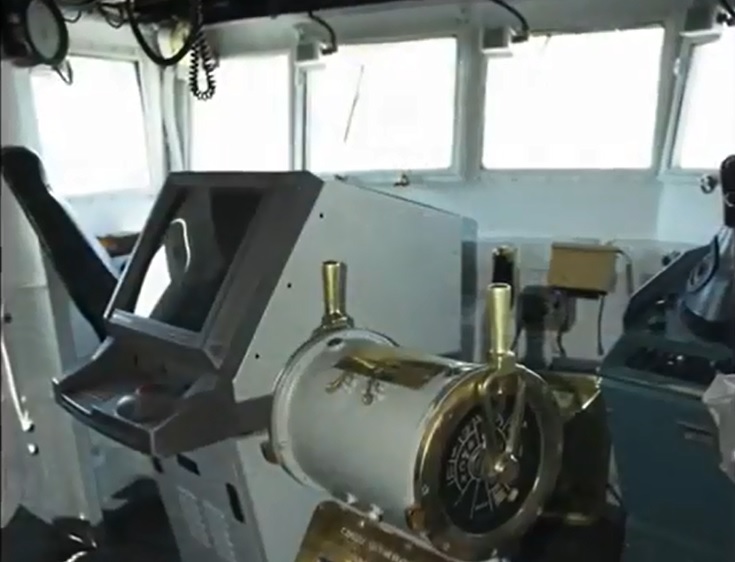 (Old and new on the bridge of ARM Netzahuacoyotl in the 2010s.)
(Old and new on the bridge of ARM Netzahuacoyotl in the 2010s.)
Last of the Gearings
In the 1990s and 2000s, the other still-remaining operators of FRAM’ed WWII-veteran Gearing class destroyers (Iran, Brazil, South Korea, Pakistan, and Taiwan) phased theirs out. By 2011, the only other example in military use was the Pakistani coast guard’s Nazim (formerly USS Damato) which was an inoperable and stripped pierside tender. ARM Netzahuacoyotl was the last Gearing still patrolling the sea, six and a half decades after WWII ended.
In 2012, it was announced that ARM Netzahuacoyotl would decommission in 2013. However the month kept getting pushed back. In December 2013, SEMAR (an organization headed by Mexico’s secretary of the navy) conducted a bow-to-stern survey of ARM Netzahuacoyotl. It was determined that the ship was safe to operate for several more months, but no more than a year. The team stated that the propulsion, hydraulic, and electrical systems were too old to refurbish and the ship was not worth refitting again. The team stressed that the hull itself, and the WWII-era 5″ guns, were still in excellent condition.
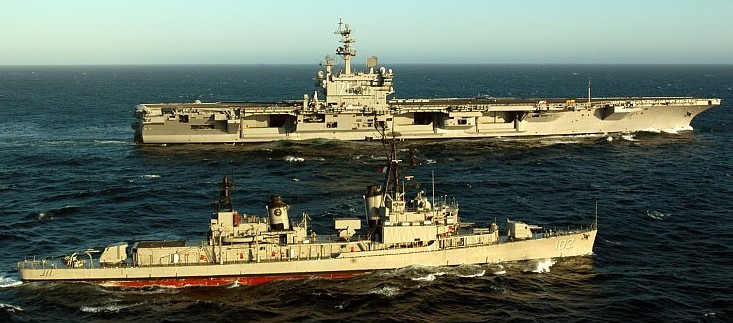 (ARM Netzahuacoyotl on 21 June 2005 during a joint exercise with USS Ronald Reagan (CVN-76) in the Pacific.)
(ARM Netzahuacoyotl on 21 June 2005 during a joint exercise with USS Ronald Reagan (CVN-76) in the Pacific.)
ARM Netzahuacoyotl made her final patrol in September 2014, just shy of 70 years of service. As of 2015, it is planned to strip the ship of salvageable equipment and scuttle the hulk as a scuba diving attraction.
https://wwiiafterwwii.wordpress.com/2015/07/04/last-of-the-gearings/
y un par de videos sobre el arm neza
July 4, 2015 jwh19754 Comments
The Gearing class was the US Navy’s final destroyer design of WWII. Without question, it was the best and most sophisticated destroyer class of WWII. Many naval historians consider it the best destroyer design ever. These ships served long after WWII in the US Navy, then were transferred around the world, serving many navies on four continents. The Mexican navy received two of these ships. One, ARM Netzahualcoyotl, ended up being the last Gearing on active duty in the world.

USS Steinaker (DD-863) was launched on 13 February 1945 at Bethlehem Steel’s Staten Island, NY shipyard. The ship commissioned on 26 May 1945.
 (USS Steinaker (DD-863) during WWII, in the original Gearing configuration.)
(USS Steinaker (DD-863) during WWII, in the original Gearing configuration.)USS Steinaker saw no actual combat during WWII, as the ship had been attached to the US Navy’s 6th Fleet in the Atlantic and Mediterranean after Germany had already surrendered.
In 1964, USS Steinaker, like many other Gearings, underwent a FRAM conversion. The Hedgehog ASW mortars and “B” twin 5″ gun turret were removed, making way for two sets of triple ASW torpedo tubes. The amidships ship-to-ship torpedoes were replaced by a RUR-5 Asroc anti-submarine missile launcher. All of the WWII-era light (40mm, 20mm, .50cal) guns were removed, as were the depth charge racks. A helipad and small hangar for the QH-50 DASH drone helicopter was added. Infrared-retarding caps were added to the stacks. The radios, radars, and sonars were completely overhauled, and some structural changes were done.

(USS Steinaker after the FRAM conversion, with the “B” turret replaced by two triple ASW tubes. The three black antennas atop the new DASH hangar are the AN/WLR-1 electronic warfare system. The “chokers” on the WWII-era stacks were meant to reduce the heat signature vs modern infrared sensors. The QH-50 DASH heli-drone was largely unsuccessful and later abandoned.)
In 1968, the modernized USS Steinaker made a combat tour off Vietnam, bombarding ashore targets with her 5″ guns. On 1 July 1973, USS Steinaker was decommissioned and transferred to the Atlantic Fleet’s 10th Destroyer Squadron naval reserve proficiency program. As such, the ship had no permanent crew and was moored pierside at Baltimore, MD; so that US Naval Reservists from Maryland and Virginia could fulfill their “….one weekend a month” obligation. This continued until 1981, when the old destroyer was judged insufficient.
Transfer to Mexico
On 24 February 1982, the US Congress agreed to the sale of the ex-USS Steinaker to Mexico. The Mexicans renamed the ship ARM Netzahuacoyotl, initially with the pennant number E-04. The destroyer was sold along with USS Steinaker‘s sister ship, the ex-USS Vogelsang (DD-852), which became ARM Quetzacoatl. The terms of the sale were fairly generous; the Mexicans did not pay much more than their scrap metal value. Basically for the USA, it was a way to clear out some reserve anchorages without the hassle of bidding a scrap job. For Mexico, it was a prime opportunity to add two open-ocean combatants to their navy, whatever their age.

(ARM Netzahuacoyotl departs for a patrol in the Pacific Ocean in 1991. The pennant number is still E-04. The Mexican navy had a spree of ship renamings and renumberings in the 1990s and E-04 later changed to E-11 and then again to D-102.)

(ARM Netzahuacoyotl’s bell, which was forged in Mexico after the transfer. Since the Revolutionary War, US Navy sailors have held a superstitious respect for ship’s bells and American bells are usually removed before ex-US Navy warships are sold abroad. US Navy veterans of a certain age might recognize the red object on the bulkhead, it is an old fog applicator extension for firefighting.)
Initially no modifications were done to the ship. For Mexico, their prime assets were their range, seaworthiness in bad weather, long-range air search radars, and anti-submarine weapons.

(One of ARM Netzahuacoyotl’s two Mk32 Mod7 324mm torpedo tube banks. These fired the Mk46 acoustic-homing ASW torpedo with a range of about 5 miles.)

(ARM Netzahuacoyotl’s Mk112 launcher, which American sailors called “the pepperbox”, with the Mexican flag above. This launcher, installed in the 1960s to replace the WWII-era anti-ship torpedoes, fired RUR-5 Asroc ASW missiles out to 12NM range. Asroc missiles carried a homing torpedo and dropped it into the sea directly over the target submarine’s position. Normally, a submarine can detect a regular incoming torpedo and take evasive maneuvers. With Asroc, there was only a few seconds between the torpedo splashdown and it’s impact. Mexico also used the RUR-5 on it’s more modern Bronstein and Knox class warships, so ARM Netzahuacoyotl was a good training asset.)
The hangar built during the FRAM upgrade was sized for the long-forgotten little DASH heli-drone and was too cramped for a regular 1980s-era helicopter. None the less, the flight deck was still usable and the Mexican navy sometimes used ARM Netzahuacoyotl as a landing spot.

(A German-made Bo-105 helicopter of the Mexican navy firing a rocket.)
The two remaining Mk38 twin 5″ gun turrets were kept in immaculate condition by the Mexicans. They did not regard them as museum pieces and maintained excellent gunnery standards with these WWII weapons into the 21st century.
 (The WWII-veteran aft Mk38 twin 5″ gun aboard ARM Netzahuacoyotl during a friendship visit to the USA in the 2000s.)
(The WWII-veteran aft Mk38 twin 5″ gun aboard ARM Netzahuacoyotl during a friendship visit to the USA in the 2000s.)
(A Mexican sailor, with modern kevlar PASGT helmet, loads a 5″ shell into the magazine shuttle for transport up into the WWII turret.)

(The inside of one of ARM Netzahuacoyotl’s twin 5″ turrets during the 2000s. This shows the hand-loaded breech mechanism of the WWII-era 5″ guns. The helmets are a mix of modern kevlar PASGT and old WWII-era M1 steel pots. Considering age, the gun and the turret’s interior are in pristine condition. The Mexican navy has high shipboard standards.)

(Aboard ARM Netzahuacoyotl during the 2000s. The structure, with controlman’s bubble, in the foreground is a Mk37 director which dates back to WWII. Atop it is a Mk22 gunnery radar. This system controlled the gunfire of the 5″ weapons. On the mast can be seen the two modern AN/SPS-59 navigation radars which were added by Mexico after the transfer, and the large AN/SPS-29 air search radar which was installed during the FRAM upgrade.)
Mexican operations
Initially, the role of ARM Netzahuacoyotl was supposed to be peacetime training and wartime ASW patrols in the Pacific Ocean. The ship’s age and limited abilities were not really important, as the Mexican navy is in a unique strategic position: sandwiched between an infinitely stronger superpower navy north of the Rio Grande; and much weaker and smaller third-world navies south of the Yucatan.
As it turned out, the USA’s war on drugs, which intensified during the 1980s, ended up being the ship’s main duty. Normally, ARM Netzahuacoyotl patrolled a sea zone of the Pacific just south of the Baja peninsula northwards up to the sea border of the USA. This area was rife with trawlers, yachts, and small boats smuggling drugs from South America towards California.

(ARM Netzahuacoyotl departing port for a “narcopatrol” in the Pacific Ocean.)
For these anti-drug missions, ARM Netzahuacoyotl‘s main assets were the ship’s wide operating radius and the air search radar. The 1960s-vintage AN/SPS-29 was obsolete in a military context by the 1990s, but, it could still detect a DC-3-sized smuggling plane at high altitude out beyond 100NM, and even small Cessnas at wavetop height out to about 38NM.
Since ARM Netzahuacoyotl‘s radios were all American, they were compatible with those of the US Coast Guard. Any suspected smuggler which ARM Netzahuacoyotl could not chase down, was vectored via radio to the DEA or US Coast Guard. The helipad allowed search helicopters a safe place to land at sea if needed. Unlike the Mexican navy’s small fiberglass anti-drug boats, the sturdy WWII-built ARM Netzahuacoyotl was not deterred by severe weather.
For the crew, a highlight of serving aboard ARM Netzahuacoyotl was a yearly visit to San Diego, CA. The Mexican navy often offered the American public tours of the old warship. If visitors were WWII-era US Navy veterans, especially old destroyermen, the crew of ARM Netzahuacoyotl went out of their way to welcome them, often showing the old-timers normally restricted areas such as the weapons magazines and radar room.
The SAK Mk.2 gun trials
In 1993, ARM Netzahuacoyotl was selected as the trials ship for the modern SAK Mk.2 gun. Manufactured by Bofors in Sweden, this 57mm autocannon is unmanned and housed in a plastic-composite structure designed for low observability by radar. It fires at 220rpm and is radar-controlled. For the trials, the two torpedo tube banks were removed and the SAK Mk.2 was installed on a temporary platform where the “B” Mk38 turret had once been, long ago in WWII.
 (The white Bofors 57mm autocannon installed aboard ARM Netzahuacoyotl in the mid-1990s. This photo also shows the final radar fit, with the black AN/SPS-29 and smaller AN/SPS-10 sets from the FRAM upgrade, along with the white, bar-shaped Kelvin Hughes 17/9 modern system installed by the Mexicans at the end of the 1980s atop the mast. The two AN/SPS-59 sets on the yardarms are hard to make out but there. The old AN/WLR-1 electronic warfare radomes remain aft.)
(The white Bofors 57mm autocannon installed aboard ARM Netzahuacoyotl in the mid-1990s. This photo also shows the final radar fit, with the black AN/SPS-29 and smaller AN/SPS-10 sets from the FRAM upgrade, along with the white, bar-shaped Kelvin Hughes 17/9 modern system installed by the Mexicans at the end of the 1980s atop the mast. The two AN/SPS-59 sets on the yardarms are hard to make out but there. The old AN/WLR-1 electronic warfare radomes remain aft.)The Bofors autocannon was generations ahead of the old WWII guns and made an interesting contrast being carried on the same ship as them. Tests were successful, and the Mexican navy purchased this gun system for other new-build warships. During the tests, the Asroc launcher was also taken ashore for cleaning and repairs.
 (ARM Netzahuacoyotl in the 1990s, with the Bofors 57mm mount aboard and torpedoes and Asroc temporarily taken off. A Reliance class cutter of the US Coast Guard is in the background.)
(ARM Netzahuacoyotl in the 1990s, with the Bofors 57mm mount aboard and torpedoes and Asroc temporarily taken off. A Reliance class cutter of the US Coast Guard is in the background.)After the conclusion of the tests, there was some thought given to leaving the SAK Mk.2 aboard as it was quite popular with the destroyer’s crew. However (at that time) it was thought that ARM Netzahuacoyotl would decommission soon, so it was moved to new warship under construction. The torpedo tubes and missile launcher were reinstalled.
 (The two triple torpedo tubes and amidships Asroc launcher back aboard after the gun tests. This was originally a Mexican navy press photo and the pennant number was airbrushed out for security.)
(The two triple torpedo tubes and amidships Asroc launcher back aboard after the gun tests. This was originally a Mexican navy press photo and the pennant number was airbrushed out for security.) (The WWII-era forward 5″ guns of ARM Netzahuacoyotl in action in the early 2000s. These long-obsolete guns were battle ready right up until the end. To the right of the port side torpedo tubes, is a discolored area of deck where the 57mm gun mounting had been.)
(The WWII-era forward 5″ guns of ARM Netzahuacoyotl in action in the early 2000s. These long-obsolete guns were battle ready right up until the end. To the right of the port side torpedo tubes, is a discolored area of deck where the 57mm gun mounting had been.)Final years
In 2002, Mexico’s other WWII-era Gearing class destroyer, ARM Ilhuicamina (formerly ARM Quetzalcoatl, before that USS Vogelsang) was decommissioned and it was expected that ARM Netzahuacoyotl would shortly follow. However because of the drug war, it remained in service. It was also used as a training ship for midshipmen of the Mexican naval academy.
After the turn of the millennium, the biggest handicap was the 1940s steam plant. As steam propulsion operates under high pressure and high moisture, the metal ages and there is little that can be done to reverse it after so many decades of use. ARM Netzahuacoyotl typically did not exceed 17kts after the year 2000 unless absolutely necessary.

(ARM Netzahuacoyotl’s engineering officer of the watch monitors the WWII-era steam board in the late 2000s. The handwheel controls the amount of steam sent from the boilers to the geared turbines which turned the propeller shafts.)
In 2010, it was announced that the ARM Netzahuacoyotl would shortly decommission however this was again extended. A new issue at that time was ordnance. By then, the 5″ ammunition had gone out of production worldwide and Mexico’s remaining stockpile was beginning to be depleted. The RUR-5 missile had just been phased out by the US Navy, so Mexico’s remaining inventory of that missile (which cost about $375,000 each) had to be shared with more modern frigates and ARM Netzahuacoyotl obviously had last priority.
 (Old and new on the bridge of ARM Netzahuacoyotl in the 2010s.)
(Old and new on the bridge of ARM Netzahuacoyotl in the 2010s.)Last of the Gearings
In the 1990s and 2000s, the other still-remaining operators of FRAM’ed WWII-veteran Gearing class destroyers (Iran, Brazil, South Korea, Pakistan, and Taiwan) phased theirs out. By 2011, the only other example in military use was the Pakistani coast guard’s Nazim (formerly USS Damato) which was an inoperable and stripped pierside tender. ARM Netzahuacoyotl was the last Gearing still patrolling the sea, six and a half decades after WWII ended.
In 2012, it was announced that ARM Netzahuacoyotl would decommission in 2013. However the month kept getting pushed back. In December 2013, SEMAR (an organization headed by Mexico’s secretary of the navy) conducted a bow-to-stern survey of ARM Netzahuacoyotl. It was determined that the ship was safe to operate for several more months, but no more than a year. The team stated that the propulsion, hydraulic, and electrical systems were too old to refurbish and the ship was not worth refitting again. The team stressed that the hull itself, and the WWII-era 5″ guns, were still in excellent condition.
 (ARM Netzahuacoyotl on 21 June 2005 during a joint exercise with USS Ronald Reagan (CVN-76) in the Pacific.)
(ARM Netzahuacoyotl on 21 June 2005 during a joint exercise with USS Ronald Reagan (CVN-76) in the Pacific.)ARM Netzahuacoyotl made her final patrol in September 2014, just shy of 70 years of service. As of 2015, it is planned to strip the ship of salvageable equipment and scuttle the hulk as a scuba diving attraction.
https://wwiiafterwwii.wordpress.com/2015/07/04/last-of-the-gearings/
y un par de videos sobre el arm neza
Heroica Escuela Naval Militar
El 11 de noviembre de 1952 el Presidente de la República Licenciado Miguel Alemán Valdez inauguró las actuales instalaciones, ubicadas en el poblado de Antón Lizardo, Veracruz; instalaciones que a la fecha han servido para formar de manera eficaz, a quienes se desempeñan como guías y capitanes de la Armada al servicio de la sociedad en general.
La Escuela Naval Militar es Heroica por los hechos gloriosos de sus hijos, el Teniente de Artillería José Azueta Abad y el Cadete Virgilio Uribe Robles, quienes ofrendaron su vida de manera heroica al defender la escuela y con ello la patria, ante la segunda invasión norteamericana al puerto de Veracruz, el 21 de abril de 1914.























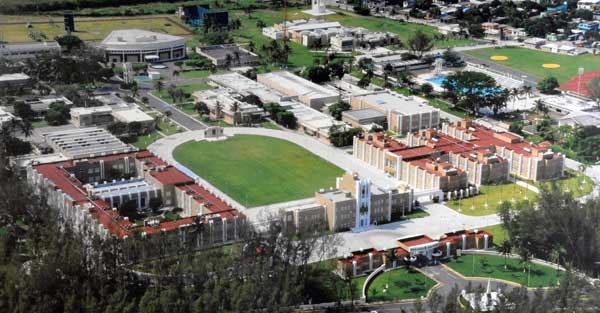

El 11 de noviembre de 1952 el Presidente de la República Licenciado Miguel Alemán Valdez inauguró las actuales instalaciones, ubicadas en el poblado de Antón Lizardo, Veracruz; instalaciones que a la fecha han servido para formar de manera eficaz, a quienes se desempeñan como guías y capitanes de la Armada al servicio de la sociedad en general.
La Escuela Naval Militar es Heroica por los hechos gloriosos de sus hijos, el Teniente de Artillería José Azueta Abad y el Cadete Virgilio Uribe Robles, quienes ofrendaron su vida de manera heroica al defender la escuela y con ello la patria, ante la segunda invasión norteamericana al puerto de Veracruz, el 21 de abril de 1914.

























Continúan las entregas de patrulleras tipo Defender para la Armada de México.
Actualmente la Armada de México cuenta con cerca de 50 unidades de Defender y se encuentra a la espera de que se incorporen más unidades al servicio.


Las Defender de la Armada de México se complementan con las MLB Textron.
Miden 47 pies de largo, desarrollan una velocidad de 25 nudos, son de aluminio, pueden navegar en mar gruesa con olas de hasta 6 metros soportando fuerzas de hasta 3G, tienen la característica de que si se voltean vuelven a su posición normal en menos de 10 segundos completamente operacionales.

Aquí demuestran sus capacidades.
Actualmente la Armada de México cuenta con cerca de 50 unidades de Defender y se encuentra a la espera de que se incorporen más unidades al servicio.


Las Defender de la Armada de México se complementan con las MLB Textron.
Miden 47 pies de largo, desarrollan una velocidad de 25 nudos, son de aluminio, pueden navegar en mar gruesa con olas de hasta 6 metros soportando fuerzas de hasta 3G, tienen la característica de que si se voltean vuelven a su posición normal en menos de 10 segundos completamente operacionales.

Aquí demuestran sus capacidades.
Última edición:
Cierto la pifie con el URL del video
Continúan las entregas de patrulleras tipo Defender para la Armada de México.
Actualmente la Armada de México cuenta con cerca de 50 unidades de Defender y se encuentra a la espera de que se incorporen más unidades al servicio.


Aquí demuestran sus capacidades 3 unidades de la Armada
Lindas naves . . .
hay dos diseños de la durango uno es el sig la ARM Durango PO-151 y la ARM Sonora PO-152 con el concepto sthealEs que es un diseño forzado, ese cerramiento. No se lo vé como algo natural del diseño y mostrandome los buques me dá la razón.
Besos
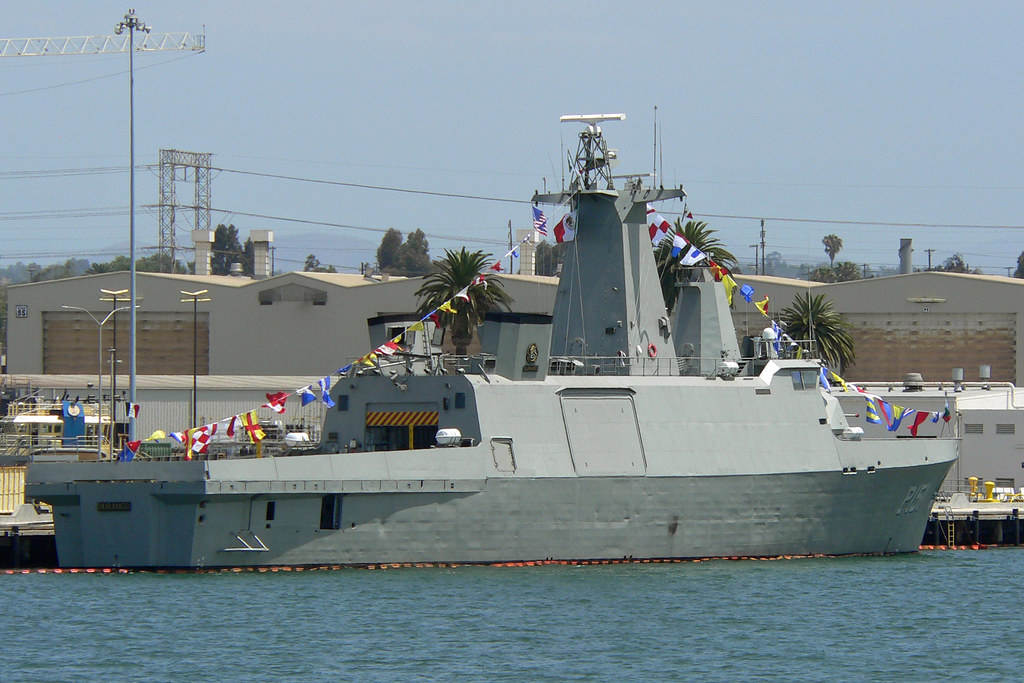
arm durango PO-151
y el rediseño en las ARM Guanajuato PO-153 y ARM Veracruz PO-154

ARM Guanajuato po-153

ARM Veracruz PO-154
mas fotos en
https://flic.kr/p/17866106692 http://www.ships-photos.net/picture/show/28663/ARM-VERACRUZ
http://www.shipspotting.com/gallery/photo.php?lid=2323077
cada dos buques que salen tienen variaciones de los dos anteriores si no me crees revisa las oaxacas
la PO-161 y PO-162 son iguales
la PO-163 y PO-164 son iguales pero son muy diferentes de las dos anteriores
la PO-165 y PO-166 son iguales pero muy diferentes de las 4 anteriores
Buque de patrulla costera Scott & Sons Bowling ARM Matías de Córdova (P-02) de la clase Azteca de la Armada de Mexico.
A inicios de los años 70, la Secretaría de Marina encarga a Inglaterra 22 de estas embarcaciones, para realizar tareas de vigilancia costera y mar territorial. Fueron construidas por tres diferentes astilleros en ese país; Ailsa Shipbuilding Co. Ltd, Scott & Sons Bowling y James Lamont & Co. Ltd, entre 1974 y 1976. Hasta donde sabemos, nuestro paías fue el único usuario de este tipo de patrullas.
Las clase Azteca eran embaraciones con una eslora de 34 metros, un desplazamiento de 130 toneladas, impulsadas por dos motores diésel Ruston-Paxman Ventura 12YCM de 12 cilindros con 7,200 hp cada uno que movían dos hélices y le daban una velocidad máxima de 24 nudos. Tenían una dotación de hasta 24 personas. Estaban artilladas con un cañón sueco de 40 mm Bofors L70 a proa y un cañón suizo de 20 mm Oerlikon GAM-B01 a popa.
Con los años fueron dándose de baja, para inicios del siglo XXI quedaban 20 en operación y al comenzar la segunda década, sólo 10 unidades, siendo sustituidas actualmente en sus funciones por las nuevas Patrullas costeras de construcción nacional bajo licenciade la clase Tenochtitlan (Damen Stan Patrol 4207). Ignoramos si existan aún algunas en servicio o fueron ya dadas todas de baja.
Al fondo podemos ver un Dragaminas de fabricación estadounidense Clase Admirable, D-12.
Foto: SEMAR.

A inicios de los años 70, la Secretaría de Marina encarga a Inglaterra 22 de estas embarcaciones, para realizar tareas de vigilancia costera y mar territorial. Fueron construidas por tres diferentes astilleros en ese país; Ailsa Shipbuilding Co. Ltd, Scott & Sons Bowling y James Lamont & Co. Ltd, entre 1974 y 1976. Hasta donde sabemos, nuestro paías fue el único usuario de este tipo de patrullas.
Las clase Azteca eran embaraciones con una eslora de 34 metros, un desplazamiento de 130 toneladas, impulsadas por dos motores diésel Ruston-Paxman Ventura 12YCM de 12 cilindros con 7,200 hp cada uno que movían dos hélices y le daban una velocidad máxima de 24 nudos. Tenían una dotación de hasta 24 personas. Estaban artilladas con un cañón sueco de 40 mm Bofors L70 a proa y un cañón suizo de 20 mm Oerlikon GAM-B01 a popa.
Con los años fueron dándose de baja, para inicios del siglo XXI quedaban 20 en operación y al comenzar la segunda década, sólo 10 unidades, siendo sustituidas actualmente en sus funciones por las nuevas Patrullas costeras de construcción nacional bajo licenciade la clase Tenochtitlan (Damen Stan Patrol 4207). Ignoramos si existan aún algunas en servicio o fueron ya dadas todas de baja.
Al fondo podemos ver un Dragaminas de fabricación estadounidense Clase Admirable, D-12.
Foto: SEMAR.

lista de buques de la armada de mexico y buques dados de baja por sexenio actualizandose constantemente
pregunto se ve la info de mi post o no
BR-58 la cual es una defender fc-33 avistada en este video
Última edición:
Temas similares
- Respuestas
- 0
- Visitas
- 270
- Respuestas
- 5
- Visitas
- 1K
Z
La conversión a patrullero de la corbeta ARA Parker de la Armada Argentina se encontraría paralizada
- Zona Militar
- Zona Militar en Youtube
- Respuestas
- 0
- Visitas
- 151
Z

 , sólo diferente.
, sólo diferente.